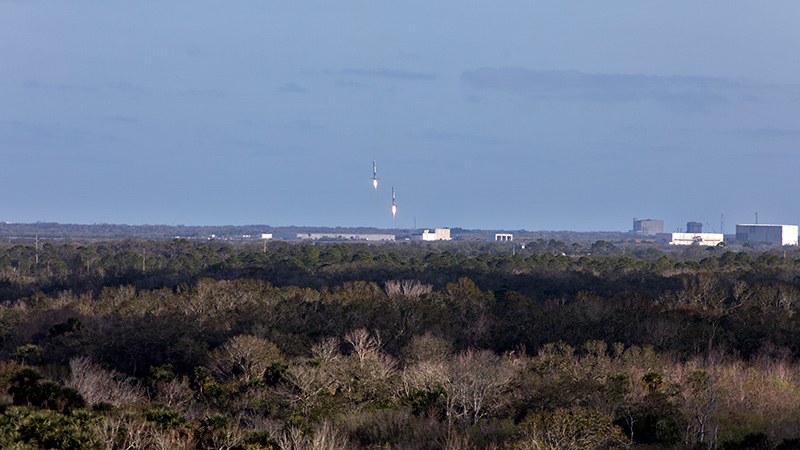SpaceX launches Falcon Heavy
By Tom Risen|February 6, 2018
The 27-engine rocket stokes competition against United Launch Alliance, Arianespace
When SpaceX’s first Falcon Heavy rocket roared off a pad in Florida on Tuesday, it carried Elon Musk’s now famous bright red Tesla and the possibility of the California company gaining a large price edge in the competition to launch satellites for the Pentagon and National Reconnaissance Office.
The rocket lifted off at 3:45 p.m. ET, two hours and 15 minutes later than planned due windy conditions. A SpaceX live stream showed two of the rocket’s three Falcon 9 cores returning to Earth a few minutes later, touching down simultaneously on landing pads at Cape Canaveral, with a narrator saying, “The Falcons have landed.”
The fate of the Falcon 9 core that was headed for a drone ship in the Atlantic Ocean was unknown for a time, because the SpaceX live stream shut off. A few hours later, Musk said during a press conference that “apparently” the core “hit the water going at 300 mph and took out two of the three engines on the drone ship.” He said the company might eventually show the footage “ in a “blooper reel.”
The Falcon 9 rockets that made up the Falcon Heavy are not the latest Block 5 variant of the cores, so Musk said the company had not planned to reuse the three cores from Tuesday’s launch.
In the long-term, though, the reusability of those cores lies at the center of Musk’s strategy to win contracts and open the space frontier by cutting launch costs.
SpaceX aims for the Falcon Heavy to compete for national security-related launches against United Launch Alliance, a partnership of Boeing and Lockheed Martin that had a de facto monopoly on such contracts before the Air Force and National Reconnaissance Office also began contracting Falcon 9 rockets.
The Falcon Heavy was propelled by 27 Merlin engines, nine on each Falcon 9 core, plus a Merlin engine on the second stage to direct a payload into a specific orbit. Along with the Falcon Heavy’s reusability and liquid propellant, these numerous engines make the rocket unique compared with rival rockets in today’s market. The closest rival rocket in its class is ULA’s Delta 4 Heavy with three expendable RS-68A engines. Saturn 5 from the Apollo era was powered by five expendable F-1 engines.
SpaceX chose an old but proven technology for its Merlin engines partly because the design’s pintle, or rod-based, injector makes the engines easier to safety check than larger engines, says Vigor Yang, chair of Georgia Tech’s School of Aerospace Engineering.
Merlin “does not represent a state of the art system, it is a matured technology,” Yang says. “Each engine is easier to develop, test and certify.” The challenge of flying with Merlin engines, Yang says, is that it is harder to ignite all 27 engines at once than to ignite a handful of engines.
SpaceX unveiled the Falcon Heavy concept in 2011 and intended to launch it by 2013, but delays have since postponed test firing of its engines, which the company did last week at Cape Canaveral.
Fueling Merlin engines with legacy pintle injector technology also reduces costs on the Falcon, Yang says. SpaceX estimates the cost of a Falcon Heavy launch to be $90 million, but adds the rocket can lift payloads that are three to four times as heavy as a single Falcon 9, which costs an estimated $62 million to launch. The Falcon Heavy can lift 63,800 kilograms to low Earth orbit, 26,700 kg to geosynchronous orbit, and can send a payload of 16,800 kg to Mars, according to SpaceX.
The amount of payload a rocket can carry on missions to low Earth orbit is a top selling point for launch providers: a single ULA Delta 4 rocket can carry 28,370 kg to low Earth orbit, while the Ariane 5 built by France-based Arianespace can lift 20,000 kg per launch, according to those companies.
The Falcon Heavy could have “a huge cost advantage” against competitors like ULA and Arianespace by offering more power per flight and the potential to carry multiple large satellites at once, says Marco Caceres, director of space studies for the Teal Group market research firm in Virginia. The ability to launch from Cape Canaveral in Florida or Vandenberg Air Force Base in California also gives SpaceX flexibility on the timing of launches and opportunities to carry payloads from either coast, Caceres says.
“Falcon Heavy has the chance to launch the biggest satellites for [the National Reconnaissance Office] which is the lucrative side of the national security launch business,” he says. “It has a lot of potential to transform the market.”
SpaceX launched its third national security-related payload on Jan. 9, but the company and government have been silent on the apparent destruction of the Zuma satellite carried that day by a Falcon 9, which the company insists “performed nominally” and was not at fault.
Musk’s long-term goal is for SpaceX rockets to launch humans to Mars, and the company in December posted photos of the car being prepared for launch with a tagline “a red car for the red planet.”
Editor’s note: In the NASA photo by Kim Shiflett at the top of the page, the SpaceX Falcon Heavy’s two side cores land at Cape Canaveral in Florida on Tuesday.







